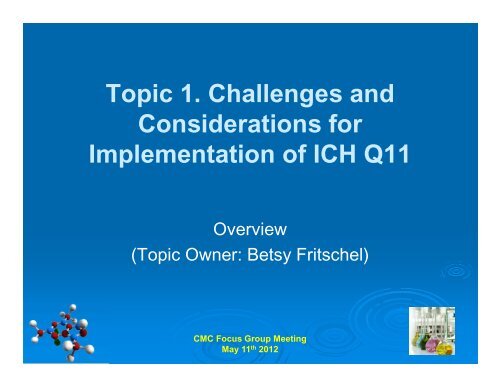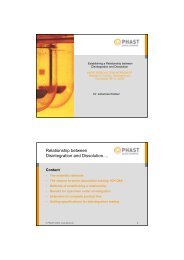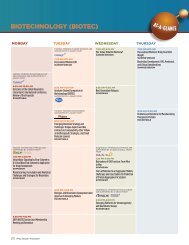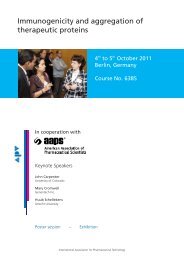Topic 1. Challenges and Considerations for Implementation of ICH ...
Topic 1. Challenges and Considerations for Implementation of ICH ...
Topic 1. Challenges and Considerations for Implementation of ICH ...
Create successful ePaper yourself
Turn your PDF publications into a flip-book with our unique Google optimized e-Paper software.
<strong>Topic</strong> <strong>1.</strong> <strong>Challenges</strong> <strong>and</strong><br />
<strong>Considerations</strong> <strong>for</strong><br />
<strong>Implementation</strong> <strong>of</strong> <strong>ICH</strong> Q11<br />
Overview<br />
(<strong>Topic</strong> Owner: Betsy Fritschel)<br />
CMC Focus Group Meeting<br />
May 11 th 2012
� New <strong>ICH</strong> Guidelines<br />
Why Q11?<br />
� Q8 Pharmaceutical Development<br />
� Q9 Quality Risk Management<br />
� Q10 Pharmaceutical Quality System<br />
� Concepts <strong>of</strong> these guidelines apply to Drug Substance<br />
as well as Drug Product<br />
� Process <strong>for</strong> manufacture <strong>of</strong> Drug Substance is very<br />
different from Drug Product – e.g. purification<br />
� Need Q11 to clarify principles <strong>of</strong> Q8, Q9, <strong>and</strong> Q10 as<br />
they relate to Drug Substance <strong>and</strong> provide examples
Current Status Q11<br />
� Step 1 EWG Consensus April 2008 – April 2011<br />
� Step 2 – Signatures May 2011<br />
� Step 3<br />
- Stage 1 Public comment June – Sept 2011<br />
- Stage 2 Resolve comments 1 st Quarter 2012<br />
� Step 4 Publication <strong>of</strong> final version<br />
� Step 5 <strong>Implementation</strong><br />
Target May 2012
<strong>1.</strong> Introduction<br />
2. Scope<br />
Outline <strong>of</strong> Q11<br />
3. Manufacturing Process Development<br />
4. Description <strong>of</strong> Manufacturing Process<br />
5. Selection <strong>of</strong> Starting Materials & Source Materials<br />
6. Control Strategy<br />
7. Process Validation/Evaluation<br />
8. Submission in CTD Format<br />
9. Lifecycle Management<br />
10. Illustrative Examples<br />
1<strong>1.</strong> Glossary
Wrap Up<br />
CMC Focus Group Meeting<br />
May 11, 2012
Breakout Session Overview<br />
Example 1: Linking Material Attributes <strong>and</strong><br />
Process Parameters to Drug Substance CQA’s<br />
� Design space <strong>and</strong> manufacturing flexibility<br />
� Traditional <strong>and</strong> Enhanced Approach in determination<br />
<strong>of</strong> ranges <strong>for</strong> parameters<br />
� Development <strong>of</strong> a Design Space using prior<br />
knowledge <strong>and</strong> chemistry first principles. (not just<br />
DoE)<br />
� Using an enhanced approach to achieve<br />
manufacturing flexibility<br />
� Using set parameters in multivariate analysis
Breakout Session Overview<br />
Example 2: Use <strong>of</strong> Quality Risk Management<br />
� Possible communication tool <strong>for</strong> presenting a risk<br />
ranking <strong>for</strong> parameters evaluated during development<br />
<strong>of</strong> a design space<br />
� Summarizes a proposal <strong>for</strong> how specific future<br />
changes will be managed <strong>and</strong> communicated during<br />
the product lifecycle
Breakout Session Overview<br />
Example 3: Presentation <strong>of</strong> A Design Space <strong>for</strong><br />
A Biotechnological Product Unit Operation<br />
� Analogous to <strong>ICH</strong> Q8R2, example 2 where a two<br />
parameter design space consists <strong>of</strong> the overlap<br />
region <strong>for</strong> two CQAs<br />
� Q11 example 3 shows the common region <strong>of</strong><br />
successful operating ranges <strong>for</strong> three CQAs<br />
� In addition, the successful operating range <strong>for</strong> one<br />
CQA (residual DNA) was derived from prior<br />
knowledge (plat<strong>for</strong>m manufacturing)
Breakout Session Overview<br />
Example 4: Selecting an Appropriate Starting<br />
Material<br />
� Illustrates general principles<br />
� Importance <strong>of</strong> considering all general principles<br />
described when selecting an appropriate starting<br />
material, rather than applying each general principle<br />
in isolation.
Breakout Session Overview<br />
Example 5: Summary <strong>of</strong> Control Elements <strong>for</strong><br />
Select CQA’s<br />
� Illustrates how part <strong>of</strong> a drug substance control<br />
strategy might be summarized in tabular <strong>for</strong>m.<br />
� Illustrates examples <strong>of</strong> upstream control, CQA <strong>and</strong><br />
specifications (<strong>and</strong>/ or drug substance specification).
Q11 Output General Comments<br />
� Regional interpretation <strong>and</strong> regulation remains a concern <strong>for</strong> QBD<br />
acceptance <strong>and</strong> uptake<br />
� Regulatory flexibility – does it exist, should it exist?<br />
� Most contentious points in discussion leading to Q11 became examples to<br />
illustrate concepts.<br />
� <strong>ICH</strong> Q11 gives examples <strong>and</strong> <strong>and</strong> is not a template
Output Example 1-Linking Material attributes <strong>and</strong><br />
process parameters to DS CQAs- development <strong>of</strong><br />
Design Space<br />
� Submissions tend to be hybrid <strong>and</strong> there is a clear acceptance that this is not<br />
bad<br />
� There is conflict over meaning <strong>of</strong> QBD terms within organizations<br />
� General agreement that organizations are not com<strong>for</strong>table using term design<br />
space in files<br />
� Design space is submitted <strong>and</strong> approved by definition<br />
� Statistics are not the only way to define a design space<br />
� DS allows that changes within DS are allowed.<br />
� Design space is useful <strong>for</strong> managing deviations outside the batch sheet <strong>and</strong><br />
allows change due to human <strong>and</strong> mechanical variability as long as it is filed!<br />
� Use <strong>of</strong> the term PAR is contentious <strong>for</strong> some.<br />
� Piecing together unit operations into a holistic CS across operations is more<br />
difficult than defining a design space <strong>for</strong> a unit operation.<br />
� Statistical analysis not always necessary but it add greater underst<strong>and</strong>ing <strong>of</strong><br />
variation<br />
� How do we file <strong>and</strong> present DS
Output Example 2- Using QRM to Support Lifecycle<br />
Management <strong>of</strong> PP<br />
� Not all parameters are created equal<br />
� Recognizes a continuum <strong>of</strong> risk<br />
� Hard to define a critical process parameter<br />
� Helps put into perspective what is critical vs non-critical it is based on<br />
risk <strong>and</strong> clearly articulated<br />
� Management <strong>of</strong> risk can change over the lifecycle <strong>of</strong> product<br />
� How do we best report the change in risk due to new knowledge during<br />
lifecycle?
� Not discussed<br />
Output Example 3
Output Example 4-Starting Materials<br />
� Strong agreement with document approach<br />
� Science based approach is welcome<br />
� Not a check box mentality<br />
� Puts the onus on the manufacturer to control the integrity <strong>of</strong> supply chain<br />
� The fewer steps you register the more control you need.
Output Example 5- Summary <strong>of</strong> Control Elements-<br />
Control Strategy<br />
� Specification <strong>of</strong> API is just a part <strong>of</strong> control strategy.<br />
� Not all CQA’s need to be included in spec or tested in API<br />
� Upstream control along with purging allows <strong>for</strong> higher levels <strong>of</strong> impurities than those defined<br />
in spec.<br />
� Certificate <strong>of</strong> Analysis vs specification- does this cause confusion?<br />
� CS table is presented in S4.5 (Justification <strong>of</strong> Spec)






